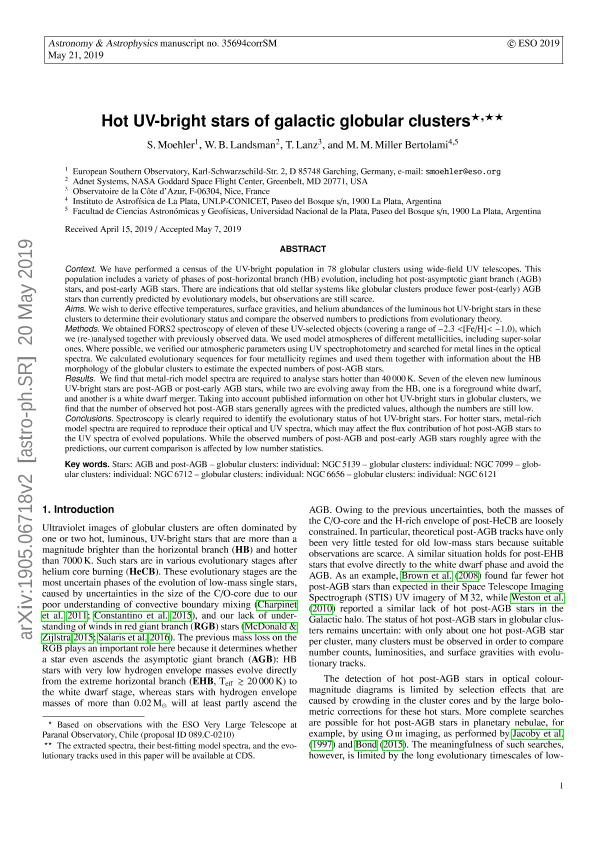Artículo
Hot UV-bright stars of galactic globular clusters
Fecha de publicación:
27/06/2019
Editorial:
EDP Sciences
Revista:
Astronomy and Astrophysics
ISSN:
0004-6361
Idioma:
Inglés
Tipo de recurso:
Artículo publicado
Clasificación temática:
Resumen
Context. We have performed a census of the UV-bright population in 78 globular clusters using wide-field UV telescopes. This population includes a variety of phases of post-horizontal branch (HB) evolution, including hot post-asymptotic giant branch (AGB) stars, and post-early AGB stars. There are indications that old stellar systems like globular clusters produce fewer post-(early) AGB stars than currently predicted by evolutionary models, but observations are still scarce. Aims. We wish to derive effective temperatures, surface gravities, and helium abundances of the luminous hot UV-bright stars in these clusters to determine their evolutionary status and compare the observed numbers to predictions from evolutionary theory. Methods. We obtained FORS2 spectroscopy of eleven of these UV-selected objects (covering a range of -2.3†< †[Fe/H]†< †-1.0), which we (re-)analysed together with previously observed data. We used model atmospheres of different metallicities, including super-solar ones. Where possible, we verified our atmospheric parameters using UV spectrophotometry and searched for metal lines in the optical spectra. We calculated evolutionary sequences for four metallicity regimes and used them together with information about the HB morphology of the globular clusters to estimate the expected numbers of post-AGB stars. Results. We find that metal-rich model spectra are required to analyse stars hotter than 40 000 K. Seven of the eleven new luminous UV-bright stars are post-AGB or post-early AGB stars, while two are evolving away from the HB, one is a foreground white dwarf, and another is a white dwarf merger. Taking into account published information on other hot UV-bright stars in globular clusters, we find that the number of observed hot post-AGB stars generally agrees with the predicted values, although the numbers are still low. Conclusions. Spectroscopy is clearly required to identify the evolutionary status of hot UV-bright stars. For hotter stars, metal-rich model spectra are required to reproduce their optical and UV spectra, which may affect the flux contribution of hot post-AGB stars to the UV spectra of evolved populations. While the observed numbers of post-AGB and post-early AGB stars roughly agree with the predictions, our current comparison is affected by low number statistics.
Palabras clave:
GLOBULAR CLUSTERS: GENERAL
,
STARS: AGB AND POST-AGB
Archivos asociados
Licencia
Identificadores
Colecciones
Articulos(IALP)
Articulos de INST.DE ASTROFISICA LA PLATA
Articulos de INST.DE ASTROFISICA LA PLATA
Citación
Moehler, Sabine; Landsman, W. B.; Lanz, T.; Miller Bertolami, Marcelo Miguel; Hot UV-bright stars of galactic globular clusters; EDP Sciences; Astronomy and Astrophysics; 627; A34; 27-6-2019; 1-15
Compartir
Altmétricas




